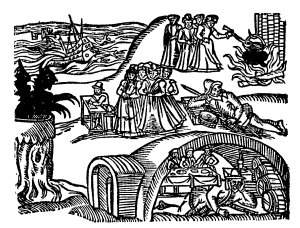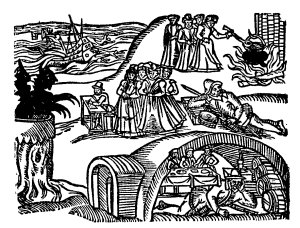North Berwick Witch Trials
5.0(1)
5.0(1)
Card Sorting
1/29
Earn XP
Description and Tags
Study Analytics
Name | Mastery | Learn | Test | Matching | Spaced |
|---|
No study sessions yet.
30 Terms
1
New cards

What details can we pick up on from the Newes of Scotland illustration?
1591\. Shipwrecks caused by witches, cauldrons, people on the run/hiding, signing devil's books/deals with the devil, groups of witches.

2
New cards
Who ruled England and Scotland?
Queen Elizabeth I ruled England and James VI ruled Scotland (separate).
3
New cards
What percentage of witches were executed from 1563-1727 in Scotland?
67%
4
New cards
What were the socioeconomic reasons for Witch-hunting in Scotland?
Impact of Mini Ice-Age saw increasing crop failure. Generally the masses were poorer, and the Devil's pact that offered 'never wanting' was attractive. Scottish men had more patriarchal views and thus were more inclined to prosecute women.
5
New cards
What were the religious reasons for Witch-hunting in Scotland?
Scotland was Calvinist and believed in a covenant with God, meaning there was a belief that you could have a covenant with the devil. There was a dismissal of amulets and charms which left people feeling defenceless.
6
New cards
What were the government-concerned reasons for Witch-hunting in Scotland?
The government structure was primitive compared to England and France, with local officials getting carried away and local judges sanctioning torture. ==There was also a hostility to royal control whereby tension was channelled into concerns about witches.==
7
New cards
How did the legal and justice system affect witch-hunting in Scotland?
The Scottish jury only required a majority to convict and the verdict of ‘ not proven’ could taint people’s reputation. The Scottish Witchcraft Act of 1563 made the use of witchcraft a capital offence (encouraged involvement).
8
New cards
How did the chances of being executed compare in and out of Edinburgh?
If tried in Edinburgh, the chance of being executed was at 50%. If tried outside of Edinburgh, the chance was around 90%.
9
New cards
Where is Berwick?
East coast of Scotland, 25m from Edinburgh
10
New cards
What were the four main causes of the Berwick Witch Hunts?
The Role of James VI, religious context and r==ole of the Kirk, Scottish legal system and social feuds.==
11
New cards
How did the Berwick trials begin?
Accusation and confession of Gilly Duncan, who accused Agnes Sampson.
12
New cards
What happened to Gilly Duncan?
Accused of witchcraft by employer for stealing, and linked her healing abilities to witchcraft. She refused to confess, and was then tortured. After being imprisoned, she began to name other witches.
13
New cards
What is the content/intended audience/purpose of Newes from Scotland?
Account of plot against the king and subsequent trials, commissioned by the king, containing dramatic language/sensationalised story. Witches painted as a serious threat, with witch-hunting as the ultimate way to stop it.
14
New cards
Who was Agnes Sampson, and what was she charged with?
A midwife/cunning woman/healer from Keyth, presumed to have magical powers, who was the first woman to be executed in the Berwick trials. Charged with failing to use witchcraft to heal.
15
New cards
What was the impact of Agnes Sampson‘s confession?
Convinced James that there was a widespread plot against him. She also named Barbara Napier and Richard Graham as witches, linking the supposed witch‘s plot with Bothwell.
16
New cards
Who interrogated Agnes and what happened?
James VI interrogated her, using leading questions to shape his preferred response. She set up for self-denying, yet she eventually cracked and confessed. A Devil’s Mark was found on her private areas.
17
New cards
What did Agnes Sampson confess- how many people did she name as accomplices?
200 women gathered, using a dead man and a cat in evocation. She wanted to prove she was a witch, and whispered in James’s ear what he said to his wife on his wedding night. She named 59 other accomplices.
18
New cards
What was Agnes’s impact on the hunts?
Sampson travelled widely and mixed with higher classes, meaning that the accusations moved away from Berwick. The number of those who she accused also caused the hunt to take on a wider life.
19
New cards
Who was Euphemia Macalzean?
Macalzean was accused because she was of a family feud (to do with murder and inheritance), as a prominent member of society. She was named by Gilly Duncan, who revoked this later, saying that the Seton’s had persuaded her to.
20
New cards
Who was Dr John Fian?
Accused of 20 counts of witchcraft and treason, tortured to reveal names of others. He was an easy target (affairs with multiple women, friendly with locals, and knowledgeable of Greek/Latin which was suspicious). He was tortured on demand of the king.
21
New cards
What does Dr John Fian’s case tell us about the belief in witches in this period?
Magic can be used for good/to get what you want- not always to harm. Power comes from the devil, yet God can and will interfere. ^^**Emphasis on sexual nature of witchcraft- morally unacceptable**^^**.** Men and women can be accused.
22
New cards
What was the importance of James’ trip to Denmark?
James was encouraged by the Danish that the storm was the work of English witches in conjunction with Danish witches.
23
New cards
What was James’ role?
He was often the center of accusations- treason, assassination, blood feuds etc. He often took the role of interrogator and his Daemonologie tract and Newes from Scotland demonstrated his interest. ^^**He used the trials to assist his political cause, trying to appear favourable.**^^
24
New cards
What were James’ beliefs about witches and the hunt?
He approved and recommended torture of suspects, and had a genuine belief in the divine right of the King (appointed by God). He also promoted the idea that witches actively worshipped the devil
25
New cards
What was James’ childhood like?
Surrounded by political crisis- there was an uprising against his mother and a long history of violence against monarchs. He inherited a country struggling to define its religious identity.
26
New cards
What commission appeared in 1591?
Commission on witch-hunting- either seen as decisive in maintenance of prosecutions/anxiety/control or limited/less important.
27
New cards
What was the Kirk commission in 1592?
The Kirk State commission- an act that promoted witch-hunting and allowed commissioners to empower local leaders to investigate witchcraft
28
New cards
What occurred from 1592-1597?
The National Witch-hunt- the crown and Presbyterian party found a common cause in the hunt. ==Kirk leaders were a major driving force- there was a climate of fear and suspicion.==
29
New cards
When was the climax of the witch-hunts?
1597, with 400 tried and around 200 executed. The significant Aitken case took place.
30
New cards
What happened further in 1597?
The Privy council order: the Aitken scandal may have prompted James to change policy, with all commission of justiciary recalled. All requests for commission to hold a witch trail were considered and only issued to groups of 3/4 me==n to prevent prejudice==. The hunting rage was ended and brought under control.